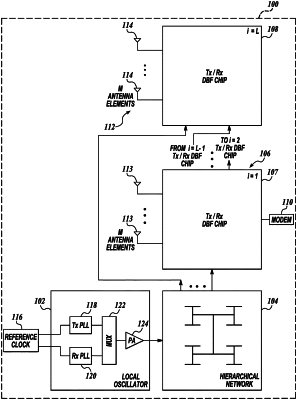| CPC H01Q 3/36 (2013.01) [H01Q 3/267 (2013.01); H04B 3/52 (2013.01); H04B 3/54 (2013.01); H04B 7/0617 (2013.01)] | 12 Claims |

|
1. A device included in a communications system, the device comprising:
a plurality of antenna elements configured in a phased array antenna;
a plurality of integrated circuit (IC) chips, wherein each IC chip of the plurality of IC chips is associated with a respective subset of antenna elements of the plurality of antenna elements, and wherein, for each IC chip of the plurality of IC chips, the associated subset of antenna elements is used for transmitting and receiving radio frequency (RF) signals by the IC chip; and
a local oscillator comprising a first phase lock loop (PLL) configured to generate a first local oscillator signal and a second PLL configured to generate a second local oscillator signal, wherein the local oscillator is configured to selectively provide the first local oscillator signal or the second local oscillator signal as a common local oscillator signal to each IC chip of the plurality of IC chips, wherein:
the first local oscillator signal and the second local oscillator signal are concurrently generated based on a common reference signal; and
the first local oscillator signal has a first frequency and the second local oscillator signal has a second frequency, different from the first frequency.
|